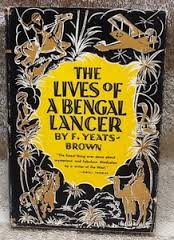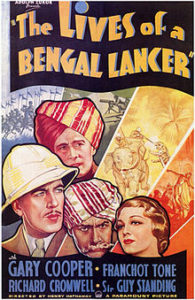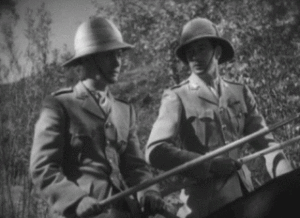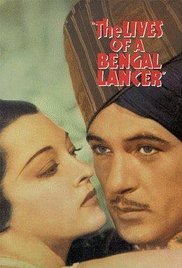The Lives of a Bengal Lancer **** (1935, Gary Cooper, Franchot Tone, Richard Cromwell, Guy Standing, C Aubrey Smith, J Carroll Naish, Akim Tamiroff, Monte Blue, Douglass Dumbrille) – Classic Movie Review 4745
Director Henry Hathaway went to the Northwest Frontier and took a crew of distinguished actors for this famous 1935 classic adventure movie epic tale of British bravado, based on the 1930 autobiography of British cavalry officer by Francis Yeats-Brown. The Hollywood blockbuster film was nominated for seven Academy Awards, including Best Director, Best Original Screenplay and Best Picture, and won for Best Assistant Director (Clem Beauchamp, Paul Wing).
Actually, of course, this is Hollywood and Hathaway, cast and crew didn’t go to the Northwest Frontier at all. Paramount was to make the film in 1931 and sent cinematographers Ernest B Schoedsack and Rex Wimpy to India to film location scenes, including a tiger hunt. Much of the film stock deteriorated in the high heat, so the project was delayed for four years and, when the film was made in 1934, much of the production took place in the hills surrounding Los Angeles.
They filmed at Alabama Hills, Lone Pine, California, Buffalo Flats, Malibu, California, Chatsworth, Los Angeles, California, the Iverson Ranch Chatsworth, Los Angeles, and at the Paramount Ranch, Agoura, California. Over 500 Hindu olive pickers were recruited in the Imperial Valley and around Oxnard, California, to play Afridi tribesmen and lancers for battle sequences.
Richard Cromwell plays Lieutenant Donald Stone, the 41st Bengal Lancers CO’s son and new arrival in India, where he is promptly captured. So fellow officers Lieutenant Alan McGregor and Lieutenant John Forsythe (Gary Cooper and Franchot Tone) have to set out to rescue him.
A witty screenplay totally reworks Yeats-Brown’s book in a way that is ideal for a Hollywood blockbuster, with plenty of excellent action scenes, good opportunities for actors to show off and a modicum of humour, now unfortunately dated. The film plot is entirely different from that of the book and none of the book’s characters appears in the screenplay, not even Yeats-Brown.
Most memorable among those who derring do in the film are Sir Guy Standing (as the father, as Colonel Tom Stone) and C Aubrey Smith as Major Hamilton, but Akim Tamiroff (Emir), J Carroll Naish (Grand Vizier), Monte Blue (Hamzulla Khan) and Douglass Dumbrille as the rebel leader Mohammed Khan (‘We have ways to make men talk’) play the bad guys and get it all their own way.
The Paramount studio provides a costly, handsome production, though the film cries out for colour, even if Charles Lang photographs it impeccably in black and white.
Running 109 minutes, it is written by Waldemar Young, Grover Jones, William Slavens McNutt, Achmed Abdullah and John L Balderston, produced by Louis D Lighton, scored by Milan Rode, choreographed by LeRoy Prinz and designed by Hans Dreier.
It triumphed at the box office, grossing $1.5 million worldwide, and started a cycle of Imperial adventure films, including The Charge of the Light Brigade (1936), Another Dawn (1937), Gunga Din (1939), The Four Feathers (1939), and The Real Glory (1939).
Hitler told British Foreign Secretary Lord Halifax in 1937 that it was one of his favourite films. ‘I like this film,’ he said, ‘because it depicted a handful of Britons holding a continent in thrall. That is how a superior race must behave and the film is a compulsory viewing for the SS.’
Standing was bitten by a black widow spider during filming.
© Derek Winnert 2016 Classic Movie Review 4745
Check out more reviews on http://derekwinnert.com







